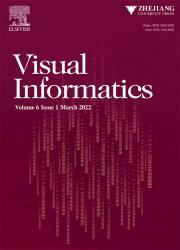Visual exploration of multi-dimensional data via rule-based sample embedding
IF 3.8
3区 计算机科学
Q2 COMPUTER SCIENCE, INFORMATION SYSTEMS
引用次数: 0
Abstract
We propose an approach to learning sample embedding for analyzing multi-dimensional datasets. The basic idea is to extract rules from the given dataset and learn the embedding for each sample based on the rules it satisfies. The approach can filter out pattern-irrelevant attributes, leading to significant visual structures of samples satisfying the same rules in the projection. In addition, analysts can understand a visual structure based on the rules that the involved samples satisfy, which improves the projection’s pattern interpretability. Our research involves two methods for achieving and applying the approach. First, we give a method to learn rule-based embedding for each sample. Second, we integrate the method into a system to achieve an analytical workflow. Cases on real-world dataset and quantitative experiment results show the usability and effectiveness of our approach.
通过基于规则的样本嵌入对多维数据进行可视化探索
我们提出了一种用于分析多维数据集的样本嵌入学习方法。其基本思想是从给定数据集中提取规则,并根据每个样本所满足的规则学习其嵌入。这种方法可以过滤掉与模式无关的属性,从而在投影中获得满足相同规则的样本的重要视觉结构。此外,分析人员可以根据相关样本满足的规则来理解视觉结构,从而提高投影的模式可解释性。我们的研究涉及实现和应用该方法的两种方法。首先,我们给出了一种为每个样本学习基于规则的嵌入的方法。其次,我们将该方法集成到一个系统中,以实现分析工作流程。真实世界数据集上的案例和定量实验结果表明了我们方法的可用性和有效性。
本文章由计算机程序翻译,如有差异,请以英文原文为准。
求助全文
约1分钟内获得全文
求助全文
来源期刊

Visual Informatics
Computer Science-Computer Graphics and Computer-Aided Design
CiteScore
6.70
自引率
3.30%
发文量
33
审稿时长
79 days
 求助内容:
求助内容: 应助结果提醒方式:
应助结果提醒方式:


